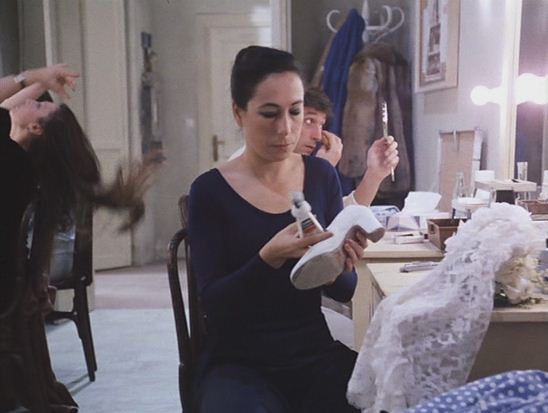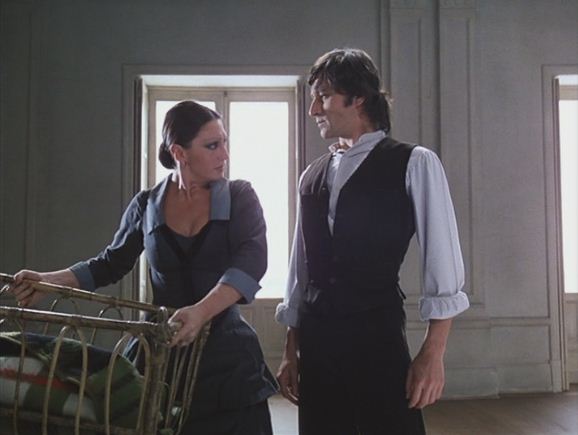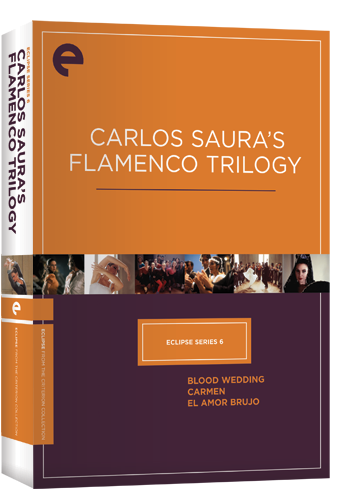Though I typically take great care to avoid hyping up anything in the “reality TV” genre, both in my online writing and in real life, I’m going to make a small exception to that self-imposed rule by mentioning that the televised dance competition known as “Dancing With The Stars” opened its ninth season last week. I am proud to admit that I’ve never sat through a single episode of that series and I don’t plan to change my viewing habits in any way, despite the reference.
Featuring a cast of obnoxious pseudo-celebrities that I would rather have gone through life never hearing about, I did take a few minutes just now to visit the DWTS website (no, I will not provide a link!) before the contrived artificiality of its premise and rank stupidity of its presentation forced me to shut down my browser and re-gather my thoughts. I’m just mentioning it here because Twitter updates and other unavoidable incidents of media seepage are what nudged me to investigate Eclipse Series 6: Carlos Saura’s Flamenco Trilogy and watch the first film in the set, Blood Wedding from 1981. I recommend it as a healthy alternative to our readers.
Saura’s films demonstrate an altogether superior handling of how to capture dance on visual media. Rather than drag entertainers of questionable ability into a gaudy gameshow popularity contest, he focuses our attention on true artists, people who dance as a means of expressing something that is genuinely meaningful to them, who’ve dedicated their life to the flamenco tradition.
As a person who’s gone through most of my adult life only semi-interested in dance as an art form (see comments I made in my review last year of The Red Shoes), I acknowledge that I’m a late bloomer to this particular discipline, though still open to learning how to better appreciate the kinetic poetry and evocative vocabulary that practitioners of flamenco and other classical dance types have developed over the centuries. But in order to do so, give me the quiet dignity and meditative atmosphere conjured up by Saura in his films over the shrieking audiences and cheezy antics of the so-called stars who seem more interested in grabbing a few seconds in the next evening’s Entertainment Tonight recap than in cultivating respect for the arts.
And if you disagree with the disparaging comments I made about DWTS here, go ahead and leave your comment below but don’t expect me to engage with you in a debate on the subject. You’re just wrong and the sooner you realize that, the better off you’ll be.
Putting that network abomination out of mind and completely behind me now, I’ll focus my attention on Blood Wedding for the remainder of this column. As I said above, dance, especially the more formal varieties such as ballet or, as is offered here, flamenco, never really generated sustained attention from me over the first five decades of my life. No disrespect intended, I just had other things more immediately interesting to explore. But studying a film like Blood Wedding reveals beauty, strength and emotive power that I hadn’t picked up on in my casual glances over the years. I have to admit that, earlier in 2010, when that notorious mass extinction event took place whereby StudioCanal revoked Criterion’s right to distribute over two dozen titles, selling them to Lions Gate instead, the loss of this Eclipse box didn’t bother me all that much, especially in comparison to titles like Grand Illusion and Pierrot le fou. I even stated in a MUBI forum that I figured I could live without the Flamenco Trilogy after watching clips from Blood Wedding on YouTube. But taking on this Eclipse column changed my mind, kicking in my completist tendencies and compelling me to purchase a set from the Criterion website this past summer, just before their supplies finally ran out, and I’m glad to have my own copy now. Series 6 is still the only Eclipse offering that’s OOP, and let’s hope things stay that way – or better yet, that Criterion eventually regains distribution rights.
From the quick viewings I’ve given to the next two titles in the series, Carmen and El Amor Brujo, the Flamenco Trilogy looks to be one that is best viewed in its original order, even though there’s no narrative continuity between the three movies. Saura works with the same basic troupe of dancers in each one, collaborating on the head of the company, Antonio Gades, along with Juan Antonio Jimenez and primera bailerina Cristina Hoyos as three familiar faces who draw the films together.
Blood Wedding is by far the simplest and most stripped-down film in the trilogy, running just a bit over an hour and spending its first thirty minutes or so just gathering the dancers together to get into character and do their warm-up exercises. We hear a short voice-over of Gades telling us about his early days as a Madrid street kid who wound up as a dancer almost by happenstance, a passage maybe of more interest once we understand that Gades was an award-winning superstar in the international flamenco scene.
After Gades calls the company together to practice a few phrases together (seen in the above clip), Blood Wedding‘s kinetic energy begins to take off in earnest. But it’s a slow smoldering build-up, and any who’s expecting a Latin version of Riverdance will probably be a bit disappointed. Saura and Gades don’t resort to flashy steps just for the sake of drumming up easy applause. They’re creating a cinematic experience and doing so in a way that leads the viewer more directly into the creative process.
The entire film is a plainly staged and shot depiction of a studio-contained rehearsal session. The dancers are in costume, but there are no props, no stage lights, no illusions of theatricality to pull our attention away from the sheer physical spectacle that is at the heart of flamenco. Musical accompaniment is also rather minimal – at first, just guitar and a trio of male singers, later, a small band and solo vocalist take over.
The story they tell is based on timeless themes, adapted from a well-known play by 20th century Spanish avant-garde writer Federico Garcia Lorca. Blood Wedding is about a pair of tragic young lovers who are denied the opportunity to pursue their romance openly due to outside pressures: he has abandoned his wife and child, she has been pledged to another through a traditional arranged marriage.
Because of the rehearsal setting, some of the story elements don’t come through as clearly on first viewing as they probably would in a full production, but the main point of the film is not the melodramatic narrative, but to create a unique blend of music, body and camera movement that watching the performance in person could not approximate.
Unless we were given permission to walk around on stage in the midst of the dancers, I suppose – but even then, as you can see in this beautifully rendered clip of the lovers’ last dance before she becomes a reluctant bride, Saura finds ways to put his camera in places that the normal human gaze can’t usually reach.
Cristina Hoyos, the woman at the heart of this rivalry, dominates just about every scene she appears in. Wearing a white dress, in a brightly lit room in front of those tall white windows, her dark features and intense facial expression become all the more riveting as she convincingly conveys the peculiar agony that accompanies a passion desire that the world refuses to allow or understand.
It’s probably not much of a spoiler to hint that Blood Wedding doesn’t lead to a happy ending – the title itself implies tragically doomed romance clearly enough. But what would be an unconscionable spoiler on my part is to post a clip of the magnificent finale that takes up the last nine minutes or so of the film: a gripping and hypnotic slow-motion knife fight between the two men who each hold their claim over the bride that must be seen only after the proper context has been established.
It’s quite an impressive display of the passion, tradition and exquisite skill that even a non-dancing yokel like me can recognize and respect.










![Bergman Island (The Criterion Collection) [Blu-ray]](https://criterioncast.com/wp-content/uploads/2022/11/bergman-island-the-criterion-collection-blu-ray-400x496.jpg)
![This Is Not a Burial, It’s a Resurrection (The Criterion Collection) [Blu-ray]](https://criterioncast.com/wp-content/uploads/2022/11/this-is-not-a-burial-its-a-resurrection-the-criterion-collection-blu-ray-400x496.jpg)
![Lars von Trier's Europe Trilogy (The Criterion Collection) [The Element of Crime/Epidemic/Europa] [Blu-ray]](https://criterioncast.com/wp-content/uploads/2022/11/lars-von-triers-europe-trilogy-the-criterion-collection-the-element-of-400x496.jpg)
![Imitation of Life (The Criterion Collection) [Blu-ray]](https://criterioncast.com/wp-content/uploads/2022/11/imitation-of-life-the-criterion-collection-blu-ray-400x496.jpg)
![The Adventures of Baron Munchausen (The Criterion Collection) [4K UHD]](https://criterioncast.com/wp-content/uploads/2022/11/the-adventures-of-baron-munchausen-the-criterion-collection-4k-uhd-400x496.jpg)
![Cooley High [Criterion Collection] [Blu-ray] [1975]](https://criterioncast.com/wp-content/uploads/2022/11/cooley-high-criterion-collection-blu-ray-1975-400x496.jpg)
This film is pure genius, and Saura is obviously a master. And hardly anybody has ever heard of it!
Few people outside the “cinephile” zone know these movies nowadays. Hopefully this post will help change that. The whole trilogy itself is a masterpiece.